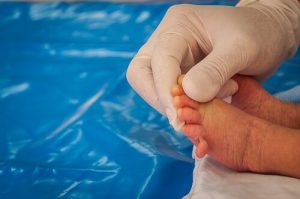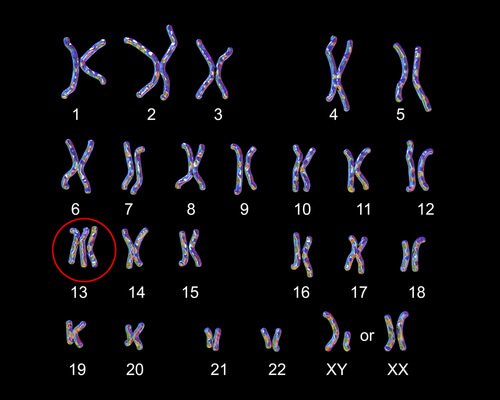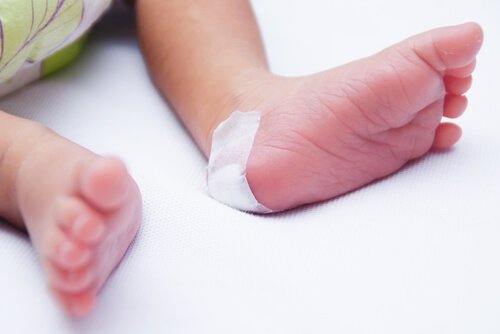Patau Syndrome in Babies: Causes, Symptoms and Treatment

Patau syndrome is an alteration that generates an extra or additional chromosome. This anomaly occurs in the womb when an issue arises during cell division.
This syndrome, also known as trisomy, was discovered by the geneticist Klaus Patau in 1960. Statistics show that 1 in every 10 thousand babies is born with Patau syndrome.
Human cells are composed of 46 chromosomes. Babies with trisomy have a total of 47 chromosomes. This change can cause major malformations.
Anomalies caused by Patau syndrome
Patau syndrome can occur either partially or completely. The severity of the syndrome will influence the baby’s life expectancy and degree of malformations present. This trisomy can cause the following:
- Genital anomalies.
- Severe mental retardation.
- Kidney cysts.
- Rotation of internal organs (the heart may be found on the right side of the body instead of the left).
- Inguinal or umbilical hernias.
- Cleft lip and cleft palate.
- Brain and heart malformations.
- Malformations of the hands, ears and bones.
- Small and close together eyes.
- Supernumerary or additional fingers or toes.
- Visual disorders as well as hearing problems, sleep apnea and seizures.
Although this syndrome isn’t hereditary, it’s more likely to be suffered by babies whose mothers are above the age of 35.
Unfortunately, the prognosis of this condition is not favorable: 80% of children with Patau syndrome do not survive the first month of life due to multiple anomalies and complications.

Patau syndrome is more common in females. The life expectancy for a child with this condition is 10 years.
Can Patau syndrome be prevented?
Unfortunately, the answer is no. However, a chromosomal study can detect the presence of trisomy at an early stage of pregnancy.
Parents who already have a child with trisomy are advised to undergo genetic tests to reduce the risk of their second child suffering from the same condition.
How is it diagnosed?
After 15 weeks of pregnancy, an accurate diagnosis can be obtained about whether the baby presents certain genetic malformations or not.
In the case of a woman who hasn’t followed up on her pregnancy, a perinatologist will be able to establish whether the baby has Patau syndrome after the birth of the child.
Tests to diagnose trisomy 13
It is important for all pregnant women to follow up on their pregnancy. This is especially vital for those who are having their first child after the age of 35.
To diagnose genetic malformations, obstetricians can use the following diagnostic methods:
- Obstetric abdominal ultrasounds. This is a painless and external method that is widely used in pregnant women.
- Chromosome map or karyotype. Fetal cells extracted from the placental tissue are used to perform this test. The cells are subjected to a biopsy to determine the presence of genetic diseases.
- Amniocentesis. This test implies obtaining fluid from the uterine sac.
- Cordocentesis. This test consists of puncturing the umbilical cord’s blood vessel in order to obtain a study sample.

Treatment for children with Patau syndrome
The treatment of this condition consists of providing personalized attention to each child. This attention depends on the particular condition and physical malformations that have to be dealt with. Heart problems are, for the most part, the cause of death among children with this condition.
Currently, there are ethical dilemmas that exist regarding whether the life of these babies should be prolonged when their life expectancy doesn’t exceed the first weeks after birth.
In addition, many people wonder whether it is worthwhile to subject these babies to major surgeries. For some, these interventions only prolong the parents’ pain and the child’s agony.
Undoubtedly, what is certain is that all babies born with this condition require medical assistance from the moment they’re born in order to make them comfortable and to give guidance to parents about how to provide palliative care from a physical and emotional point of view.
Fortunately, Patau syndrome has a very low incidence. However, parents who have gone through the painful task of taking care of a baby with this type of syndrome should not hesitate to seek professional advice to help overcome, little by little, the pain caused by the death of their little one.
All cited sources were thoroughly reviewed by our team to ensure their quality, reliability, currency, and validity. The bibliography of this article was considered reliable and of academic or scientific accuracy.
- Bazán-Ruiz, S., Bendezú-Quispe, G., & Huiza, L. (2014). Síndrome de Patau. Revista Medica Herediana, 25(1), 52-52. http://www.scielo.org.pe/scielo.php?pid=S1018-130X2014000100009&script=sci_arttext
- Edwards JH, Harnden DG, Cameron AH, Crosse VN, Wolff OH. (1960). A new trisomic syndrome. Lancet 1960; 1: 787-9.
- J Ment Defic Res. (1990). Singh. Trisomy 13 (Patau´s syndrome): a rare case of survival into adulthood. 1990; 34: 91-3.
- Sierra Santos, L., Álvarez Herrero, C., Gil Sánchez, L., & Sierra Santos, E. (2001). Un síndrome de Patau con una supervivencia que supera los pronósticos. Medifam, 11(8), 70-74. http://scielo.isciii.es/scielo.php?pid=S1131-57682001000800009&script=sci_arttext&tlng=pt
- Sugayama, S. M. M., Chong, A. K., Albano, L. M. J., Utagawa, C. Y., Bertola, D. R., Koiffmann, C. P., & Gonzalez, C. H. (1999). Estudo genético-clínico de 20 pacientes com trissomia 13 (síndrome de Patau).
This text is provided for informational purposes only and does not replace consultation with a professional. If in doubt, consult your specialist.
